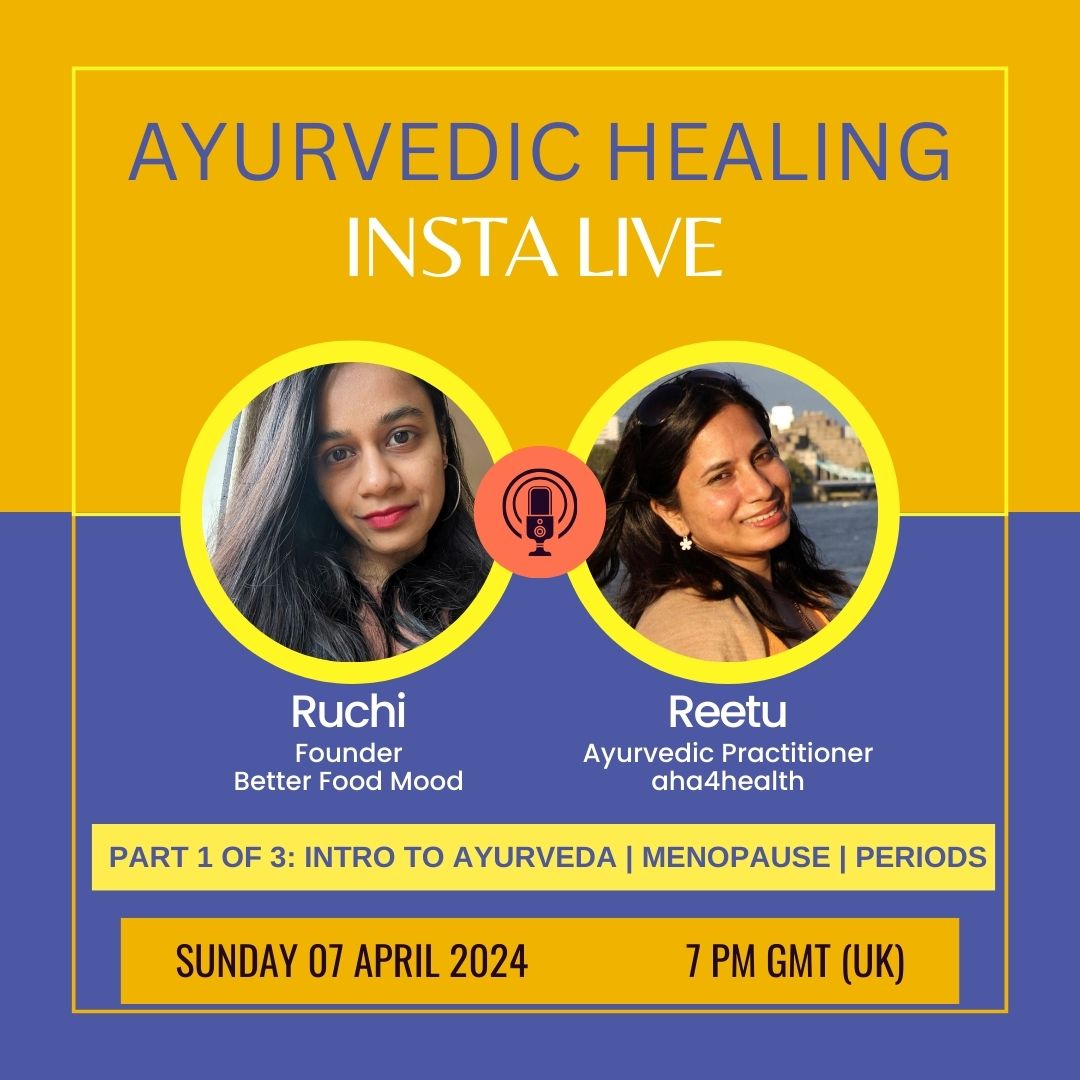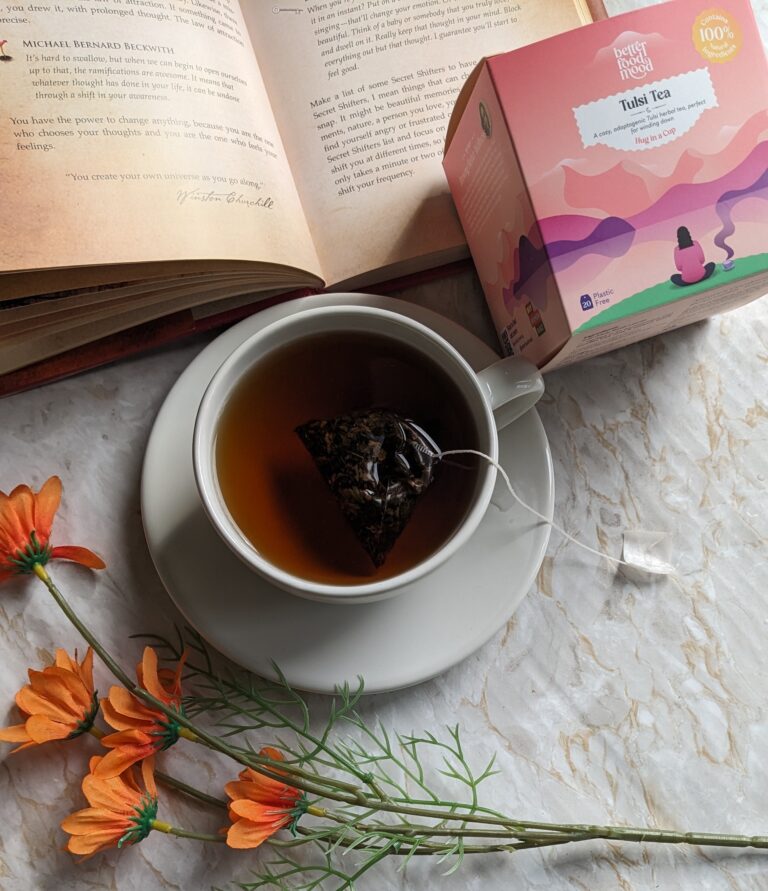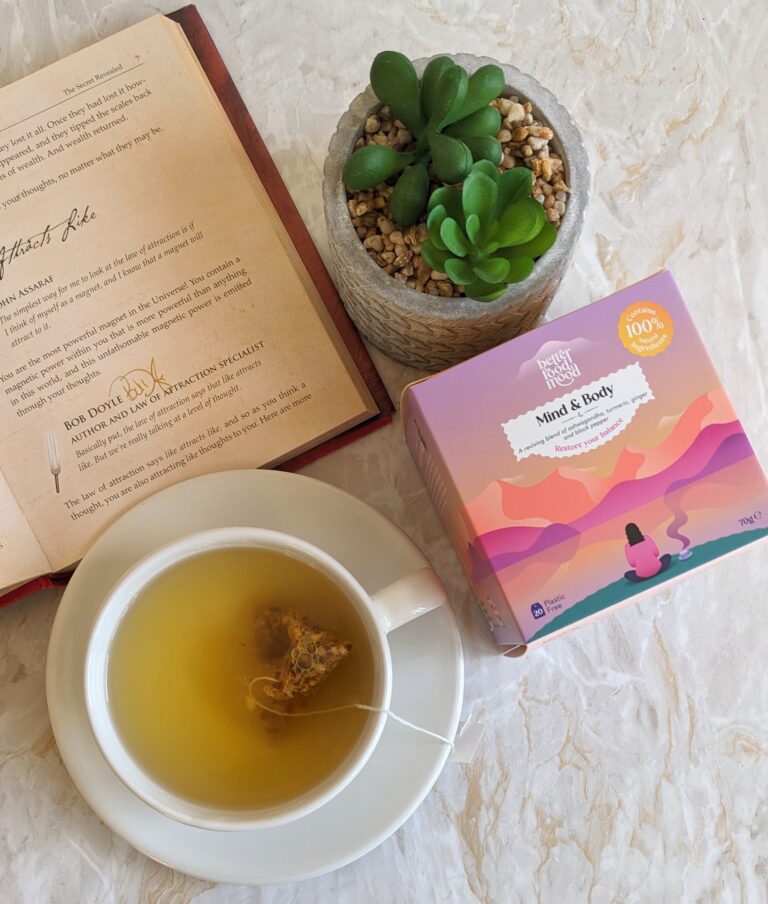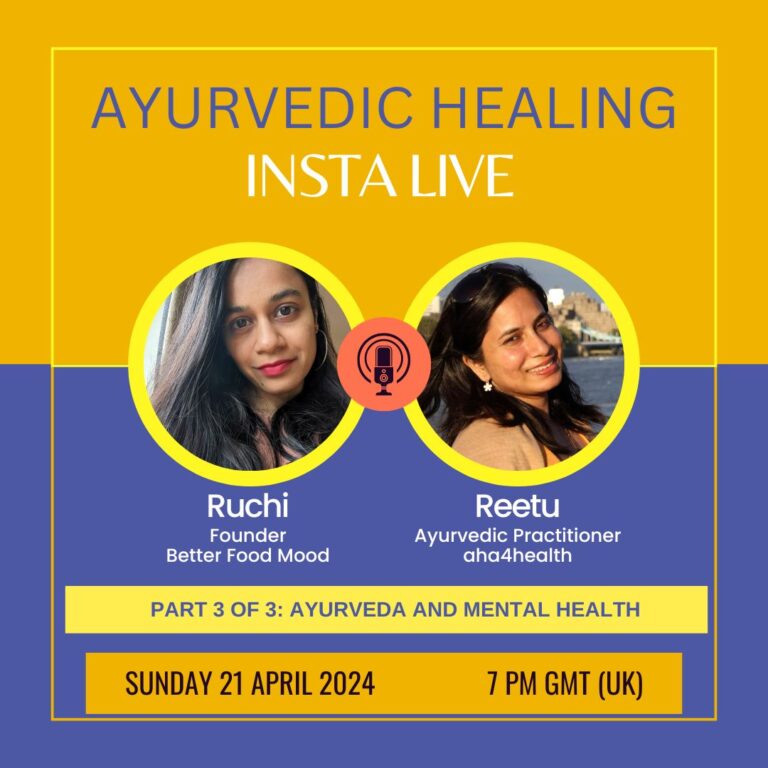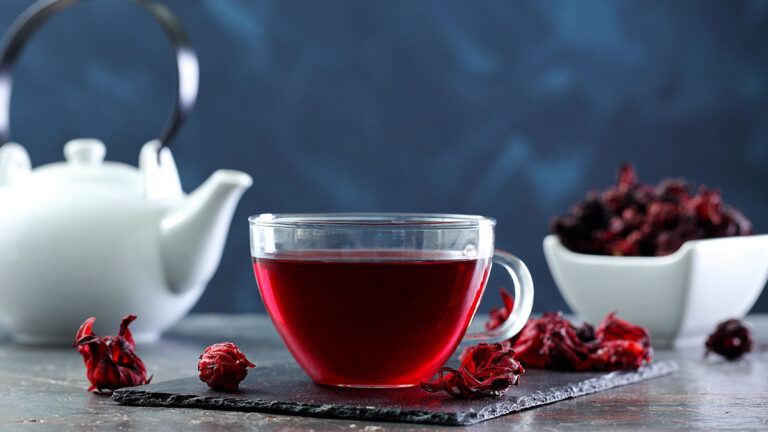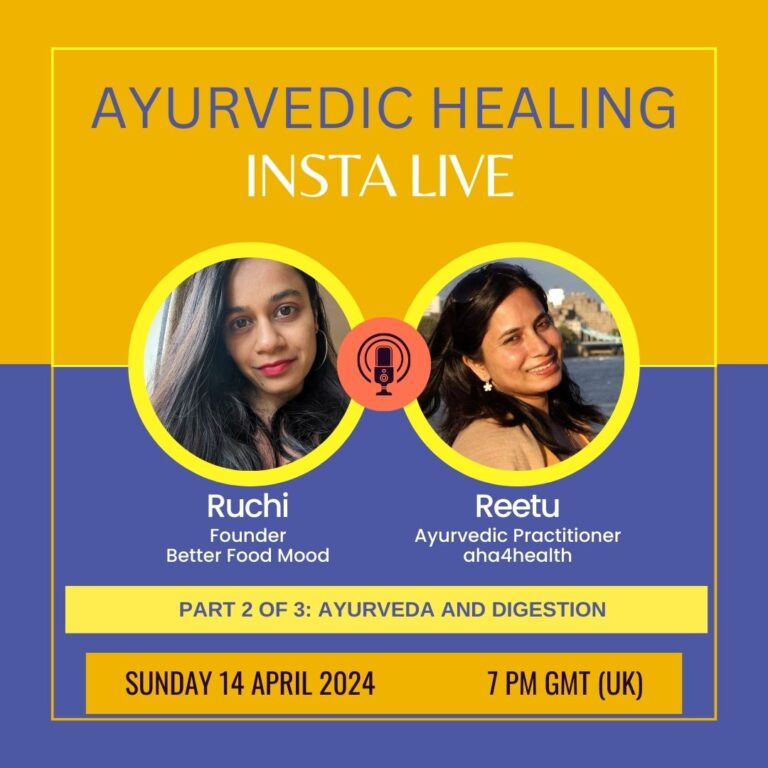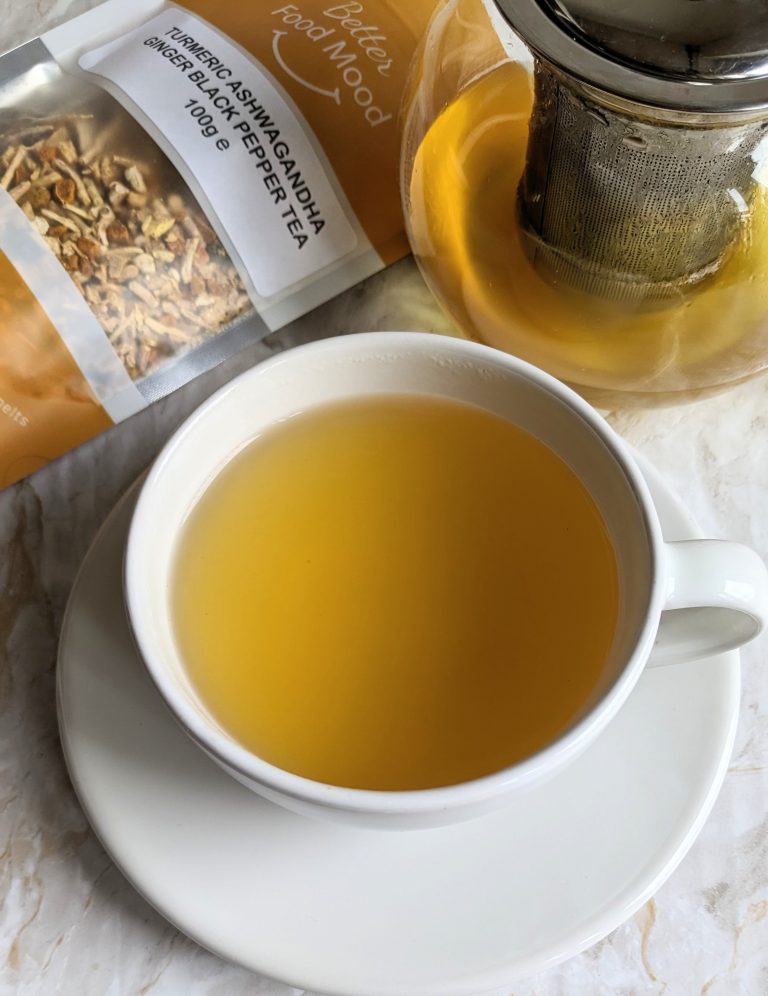Ayurveda, Period Pains and Menopause
An Introduction to Ayurveda
Last Sunday, I had the pleasure of speaking to Reetu live on Instagram, an ayurvedic practitioner and the founder of ahahealth.
It was such an insightful session where we covered a lot on Ayurveda, starting with an introduction to Ayurveda and then we touched on its role in period pains and menopause.
Reetu quoted:
If you look online, the most common definition you’ll find about Ayurveda is that it is thought to be “a science of life” or “knowledge of life”. However, she believes it is a way of life because in Ayurveda, for a person to be considered healthy, they must be healthy in mind, body, emotions and spirituality.
I absolutely loved this thought because this is exactly how I feel as well and what I’m trying to help everyone achieve through Better Food Mood.
In Ayurveda, everything is made up of five elements; Space, Water, Air, Fire and Earth.
All matter, whether organic or inorganic is comprised of these 5 elements.
Doshas (Energy Types)
In Ayurveda, there are three types of doshas. Each person is either one of these doshas or a combination of them.
- Pitta Dosha
The Pitta dosha is comprised of the elements of fire and water, with fire dominating in most cases.
It is thought that this dosha is a transformative dosha and most people who have this as their dominating dosha have good digestion/metabolism. They are able to eat a lot and not put on weight, or they are able to drink lots of alcohol and don’t get a huge hangover. If they go to the gym, they can easily gain muscle. Having a transformative energy, people from this dosha are able to achieve results faster compared to other doshas.
They generally tend to have an athletic look with sharp facial features and a sharp gaze. People with a dominant pitta energy are natural born leaders, driven, motivated, competitive and can become aggressive if their pitta goes off-balance.
Given the fire this dosha possesses, incase of an imbalance, it can be beneficial to eat a cooling diet.
2. Vata Dosha
The Vata dosha is comprised of space and air. Space and air are vast and constantly flowing hence people with this dominating dosha tend to crave a care-free lifestyle.
They are thin and find it difficult to put on weight. They have a small appetite too. As this is an air dosha, they experience irregularity on a frequent basis whether its to do with their digestion or their mood. People with a vata dosha are creative, pure, genuine and find happiness in the small things in life.
They tend to be talkative and use a lot of hand gestures when communicating. They also love change and do not like to be stagnant. They are often afraid of commitment and will find it difficult to settle down.
Incase of an imbalance, they could experience anxiety, be fearful, get constipation and arthritis too. It could be beneficial for those of a Vata dosha to create a more regular routine e.g. eating more regularly or having a regular sleep routine.
3. Kapha Dosha
The Kapha dosha is comprised of Earth and Water.
People with a dominant kapha dosha have broad shoulders and their bone structure is quite dense. They gain weight easily and struggle to lose it.
They are strong and have good endurance. For people with this dosha, it is more beneficial to have an intense short interval workout such as HIIT, rather than a slow paced exercise such as walking to lose weight.
People with this personality are often compared to a cat. They prefer to sit in one corner, listen and observe. They want everything to be given to them and they don’t like change. They can be very loyal. They are risk averse and prefer to play it safe.
Incase of an imbalance, they should eat a healthier diet and do more intense workouts.
Ayurveda and Western Medicine
We also touched on the differences between Ayurveda and western medicine.
Reetu was of the opinion that both are very essential in today’s world and they could benefit us in different ways.
- In Ayurveda, one size does not fit all and it focuses more on finding the root cause of the problem and fixing that, whereas western medicine focuses more on getting rid of the symptoms.
- In Ayurveda, prevention is better than cure. Ayurveda works to prevent problems from ever happening, whereas scientific medicine focuses on curing.
- Ayurveda is a more long term solution that can work when health care is not urgently needed e.g. if a person is experiencing an imbalance in the form of constipation. Scientific medicine is a more immediate solution that is necessary when health care is urgently needed e.g. an accident or cancer.
- Reetu believes that both could work hand in hand whereby scientific medicine could deal with more short term urgent health care and Ayurveda could deal with less urgent long term health care.
Periods
According to Ayurveda, a menstrual cycle is a 28 – 30 day period. Incase any of the following occur, then the periods are abnormal and there is an underlying imbalance.
- Irregularity e.g. not getting your periods every 28 – 30 days
- Unbearable pain
- Mood swings/irritability
- Foul smell
- Very heavy bleeding
- Skin irritations
- Blood clots
Ayurveda splits the menstrual cycle into 3 phases:
VATA PHASE
Menstration is known as the Vata phase. During this phase, if a person of the Vata energy has an imbalance, they will experience a lot of pain because the blood is not flowing as it should. If they eat cruciferous vegetables e.g. cauliflower, this could cause gas due to their erratic digestion, which could cause more pain and even contribute to back pain.
To resolve this, they should have a more regular routine e.g. eating meals regularly. They should also eat small but well cooked warm foods, avoiding raw food. A massage with warm sesame oil could also be beneficial.
KAPHA PHASE
After menstruation, the body enters into the Kapha phase which is a building phase. During this phase, if a personal of a Kapha dosha has an imbalance, they could get fibroids or cysts which store blood causing anaemia. Kapha people generally tend to have good hair but this will start falling and nails will become brittle if they become anaemic.
With fibriods, proper treatment is required. If they have an imbalance, it is better to eat more vegetables/leafy greens. Spices will aid digestion. They should eat less grains such as wheat and should also do more intense workouts.
PITTA PHASE
This is the phase where she is ovulating. If there is an imbalance, a person with a pitta dosha will experience skin irritations such as acne. As they are a dosha of heat, the heat will look for ways to escape which will result in inflammation in the body, acne being one of the signs. They could become moody and very angry.
To balance the dosha, they should eat cooling foods such as cucumber and avoid oily foods. They could also apply aloe vera topically. Juices/soups/fruits are all beneficial. Secondly, they should also “take it easy”. A break is very essential. It is worth noting that they could suffer from endometriosis incase of an imbalance and it is essential to get this checked with a GP.
Menopause
Menopause is being talked about more and more now as women open up and share their experiences.
According to Ayurveda, menopause normally occurs at 50. Given the way life has changed, whether its to do with our stressful lifestyles, environmental impact or food, women are experiencing menopause at an earlier age now.
A very simple example is makeup. When applied to skin, our skin has the ability to absorb these chemicals which can then cause hormonal changes. Most makeup will contain some kind of synthetic oestrogen which could affect our hormones. Similarly, eating food that is not organic or has been genetically modified could be affecting menopause – but not just women. This affects men too, whereby the imbalance of oestrogen and progesterone could change the physical body of a man.
Reetu mentioned that sometimes due to more serious conditions, women have to undergo procedures to remove their reproductive organs, artificially placing their body in menopause early, which in turn means they have to take synthetic hormones that can cause hot flushes. She advises that rather than doing this, these women should seek alternative medicines e.g. herbal medication which may be a better option than synthetic hormones.
Reetu Quotes:
In a normal menopausal transition, there should not be any symptoms according to Ayurveda. If there is an imbalance in the doshas, then women will experience symptoms.
Once again, menopause symptoms will differ based on the dosha.
Vatta Imbalance:
If a woman has a dominant vatta dosha and she has an imbalance, she’ll most likely experience joint pains, arthritis, dryness of hair and hair fall, her hair will grey quickly.
For this kind of imbalance, having a regular routine e.g. eating regularly, sleep and waking up regularly could help bring the dosha in balance. Consuming ashwagandha could improve mood and circulation in the body. Ashoka, which is known as the Queen of herbs, is really good for menopause too. Oiling the body with sesame oil is very beneficial in helping to relieve symptoms.
Pitta Imbalance:
If a woman has a dominant pitta dosha and she has an imbalance, she’ll experience hot flushes, urinary tract infections, poor sleep, acne, headaches, heat beneath hands and feet.
For this kind of imbalance, consuming cooling herbs like shatavari and ashwagandha could be beneficial. Also applying aloe vera topically or consuming it may help. Due to this dosha being of a fire energy, anything cooling such as swimming, staying out of the sun and even enjoying time in the moonlight by the sea is beneficial. A coconut oil massage could aid with the imbalance.
Kapha Imbalance:
If a woman has a dominant kapha dosha and she has an imbalance, she will struggle with her personal relationships and undergo depression. She will feel very cold as though all the body heat has gone. She’ll put on weight and find it difficult to lose weight. She may also experience kidney problems and diabetes.
Staying out in the sun more and getting more mental/physical stimulation could be very beneficial for this dosha. She should also endeavour to spend more time with friends and family. Finally, a sesame oil massage could aid with the imbalance.
It was such a wonderful eye-opening session for me and I hope you find the above useful too. One tip Reetu had for everyone regardless of whether they are male of female is applying hair oil which is required to ensure our scalp is moisturised and taken care of too. She emphasises that we take care of all our body parts but neglect our head. According to Ayurveda, this could cause the onset of Alzheimer’s and other mental health issues.
She advises mixing 2 parts almond oil, 2 parts coconut oil and 1 part castor oil. Apply this 3 times a week for about 10 – 30 mins. You can leave it on for 1 hour and then wash it out. This helps keep our hair and scalp moisturised and also enables blood to flow.
We will be having our next live on Sunday 14th April where we will be covering Ayurveda and digestion. See you then! 🙂

